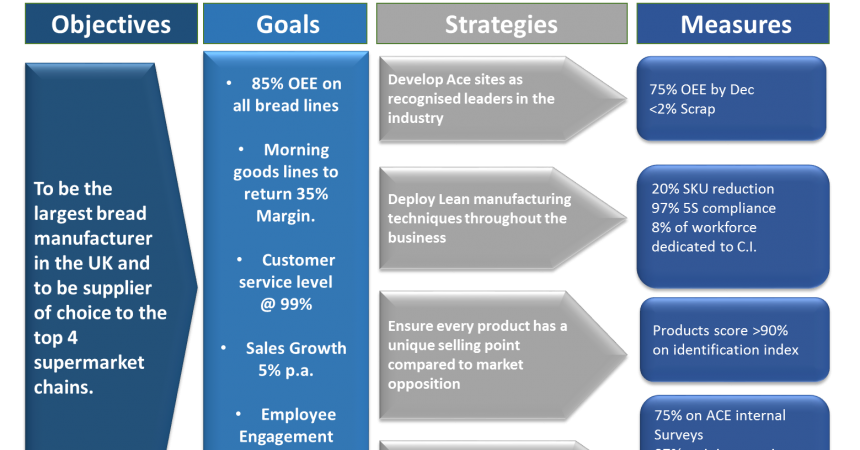Why should an organisation have O.G.S.M?
Why should an organisation have O.G.S.M?
What it is:
O.G.S.M. – Objectives, Goals, Strategies, Measures is a strategic business process to develop a simple document which captures senior management’s medium-term vision for their business in terms of 4 key questions: Where are we going? What will it look like when we get there? How are we going to get there? and How will we know we are on track?
This OGSM document is a business’s roadmap for operational excellence.
How it works
- Senior management define the Objectives of the business in words, accompanying Goals are defined using numbers, Strategies to deliver the goals are defined using words and, finally, Measures used to track the strategies are defined using numbers i.e., a simple rule: Words, Numbers, Words, Numbers.
- Secondly, the beauty of the OGSM process is that it cascades, through a number of levels, from the most senior person in the organisation to the most junior person meaning everybody in the organisation understands the direction they are heading and what their personal contribution is to getting there.
- The OGSM process is a joined-up strategy taking into account all aspects of business delivery and function i.e. Health and Safety, Customer Service, Quality, Productivity, Engagement of people, Sales, Commercial and Marketing
- For each level within the business, the OGSM document should be a 1-page document that is clear, simple and communicated widely within the business
Benefits
The OGSM process begins with the end in mind. By doing so, it focuses the mind of the senior management team on common business objectives rather than departmental or personal objectives. As the process is cascaded from the executive team to senior management to middle management and so on, similarly the process begins with the end in mind ensuring again that each level within the organisation understands how their contribution, or their department’s contribution, aligns with what really matters for the business and its customers.
The development of the OGSM is a collaborative process involving the heads of all functions and departments meaning that the output is an integrated, joined-up approach focusing on what really matters for the business and its customers taking into account interdependencies and interrelationships between resources and functions. By developing the OGSM in collaboration, organisations ensure they are working together across all functions and not in conflict as in other Silo-based organisational approaches.
Cascading the OGSM throughout the levels of responsibility within the business ensures an aligned and engaged workforce who feel able to commit to personal objectives based on an understanding of where these fit within overall business goals.
By keeping the OGSM a simple, clear, easy to understand and 1-page document, the organisation can feel confident about successful communication of the business vision within the organisation at all levels and externally to its customers. A well-constructed OGSM document can be displayed with confidence in main noticeboards and other business communication media.
By adhering to the rule of words numbers words numbers, the OGSM process delivers a meaningful and SMART (Specific, Measurable, Achievable, Realistic, Time-based) business plan.
How it is developed
- Define the starting point: An OGSM for Operational Excellence begins with addressing the question ‘Where are we now?’ This is achieved through conducting an operational excellence audit.
- Understanding Operational Excellence: Before making decisions about what is achievable in terms of business vision and accompanying goals, an executive team must be aligned in terms of their understanding of best practice and acceptance of their current position on this journey.
- Developing the Executive team OGSM: A series of facilitated workshops, led by an experienced OGSM facilitator, involving the executive team to define the Objectives and corresponding Goals and to make informed-decisions about the selection of specific operational excellence strategies which will deliver the objectives and how the effectiveness of the strategies should be tracked and measured. The outputs of this process have effectively set the Objectives and Goals for Unit Managers or Departmental heads depending on the size of the business.
- Developing Departmental OGSMs: Beginning with the Objectives and Goals which have been clearly defined by the executive team OGSM outputs, this facilitated workshop process for departmental heads or senior managers, begins with an understanding of operational excellence and current position through training and feedback from the audit. Departmental heads then select specific strategies that apply to the responsibility or department that will deliver goals and objectives that have been set for them. Depending on the size of the organisation, this cascading process may be repeated with the next level of management before finally reaching the point where individual team managers allocate specific strategies as personal objectives to their team members.
- OGSM Review: Careful selection of the correct measures during the development of the OGSM process means keeping track of the OGSM delivery is integrated into day-to-day operational management. From time to time, normally every 6 months, OGSM strategies are reviewed taking into account changes in business circumstances and opportunities.
Share:


